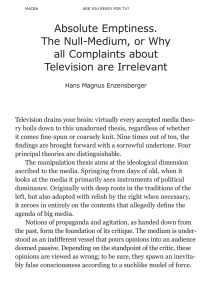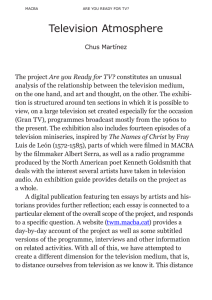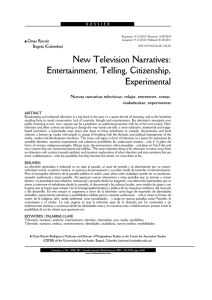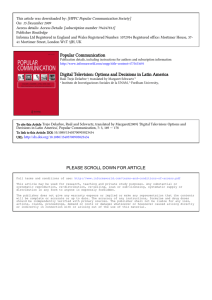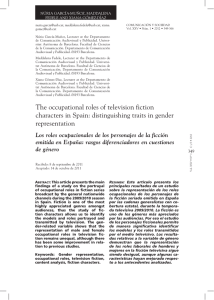Influencia de la televisión
Anuncio
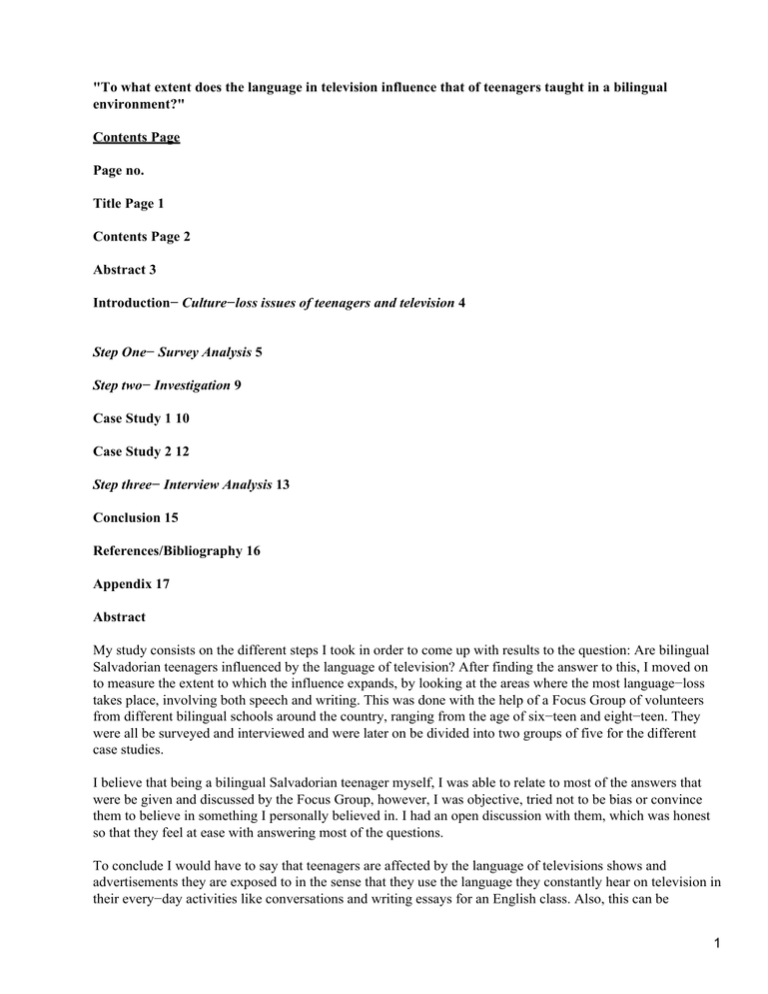
"To what extent does the language in television influence that of teenagers taught in a bilingual environment?" Contents Page Page no. Title Page 1 Contents Page 2 Abstract 3 Introduction− Culture−loss issues of teenagers and television 4 Step One− Survey Analysis 5 Step two− Investigation 9 Case Study 1 10 Case Study 2 12 Step three− Interview Analysis 13 Conclusion 15 References/Bibliography 16 Appendix 17 Abstract My study consists on the different steps I took in order to come up with results to the question: Are bilingual Salvadorian teenagers influenced by the language of television? After finding the answer to this, I moved on to measure the extent to which the influence expands, by looking at the areas where the most language−loss takes place, involving both speech and writing. This was done with the help of a Focus Group of volunteers from different bilingual schools around the country, ranging from the age of six−teen and eight−teen. They were all be surveyed and interviewed and were later on be divided into two groups of five for the different case studies. I believe that being a bilingual Salvadorian teenager myself, I was able to relate to most of the answers that were be given and discussed by the Focus Group, however, I was objective, tried not to be bias or convince them to believe in something I personally believed in. I had an open discussion with them, which was honest so that they feel at ease with answering most of the questions. To conclude I would have to say that teenagers are affected by the language of televisions shows and advertisements they are exposed to in the sense that they use the language they constantly hear on television in their every−day activities like conversations and writing essays for an English class. Also, this can be 1 considered as a language and culture loss because it implies that because they are thinking in English, their Spanish roots start to faint, and their culture along with it. Introduction− Culture−loss issues of teenagers and television Television has been around for centuries. It has become one of the most popular outlets for the media, followed by the internet, the radio and more. Before, television was used for the news, to inform and almost everything was directed to a mature audience. Nowadays, television has evolved to not only being a source of information, but also a source of entertainment, where people of all ages can find pieces of material which interests them. Language and language choices in television have a subtle, yet very forceful influence over teenagers and the way they behave. In advertising and marketing, this validation is proven to be true. The vitality of deciding on the correct language used to convey specific messages that are intended to influence an audience is extremely important. Around the world, more and more television shows and advertising is being directed to a younger demographic. In El Salvador, these changes within the televised world are more noticeable because of the aggressive nature of many of the shows and commercials. Moreover, shows and advertisements which do make their way into the country through cable television, have a wide−range exposure to Salvadorian teenagers, specially those attending bilingual schools, because of their higher level of comprehension of what is being said. When evaluating the language abilities of bilingual students both independent and social forces must be considered as impacts on language performance. Bilingualism is now both a social and linguistic event, because of its tendency to become biculturalism for students Anderson, R. (2004). It is important to note that to make a closer study, the individual environment of each person should be assessed, however, this is a more generalized study of culture and it has no intentions of being a psychological study. Language loss is also to be considered, as it is the reason why there is a preference for television in English over Spanish, for teenagers in a bilingual school. Although the English writing skills of a second−language English speaker cannot be compared to a first−language speaker, the influence of television advertisements are meant to affect all of us who understand them, to be subconsciously influenced by its words. With research, I plan to find: to what extent does the language in television influence that of teenagers taught in a bicultural environment and does this imply a culture−loss? With the help of a Focus Group, my plan is to compare their written language before and after seeing a set of television advertisements and analyse the effectiveness of the advertisements on a linguistic level, using my secondary research as the parameters of commonly used, suitable advertising language. Secondly, I will conduct an interview, where we will discuss the possibility of the loss of culture because of television. I chose to concentrate on advertising as well as television shows because they are two separate and equally important elements within the television phenomenon which need to taken into consideration. I believe this study is important because of its close relationship with culture−loss through the loss of language. This manifests itself through the preference teenagers in El Salvador, studying in a bicultural environment, have on English−speaking television over local channels which often have a very cultural approach to television broadcasting and the shows which are directed to specific age demographics, produced nationally. I find the link between advertising made for English−speaking countries with bilingual Salvadorian teenagers something interesting enough to focus on, since not many realize the impact it has on our every−day speech. Step One− Survey Analysis 2 In order to have an idea of the style of television shows and advertisements teenagers are most exposed to, I conducted a survey (included in the appendix) which had the purpose of finding what television shows are most watched by teenagers, and at what time they watch television the most. The survey was passed around a Focus Group of ten people, from different bilingual schools around the country. The questions helped me find what kind of advertisements they were exposed to the most, in order to have an idea of what their influences could be. I found a pattern within most of the surveys, that the majority of the people being surveyed watched English−only television networks, which means English−only advertising, very beneficial to my research. People were allowed to choose more than one answer in all multiple choice questions. The following graph illustrates the most watched television network and the number of people who were surveyed who watch each station. The most watched television station is ABC, which is broadcasted from the USA through cable television here to El Salvador. This channel offers news and famous television series popular in the United States, such as 20/20 and Extreme Makeover. Each person who answered the survey gave three different channels they watch the most and everyone seems to watch the same kind of programs, as there is a relatively high number of people watching each station. The following graph illustrates the most watched television shows and the number of people who were surveyed who watch each show. From the graph, it can be deducted that the most watched shows are Friends and Extreme Makeover. This is essential to my research, as I need to know which shows are more popular amongst teens, to see what kind language they are being exposed to through the show and the television commercials shown during the same show. Another important piece of information collected through the survey was the hours at which teenagers spent most time watching television. This also helps when trying to measure the expose of the advertisements. Different times are meant for different demographics. However, this depends on the station and the hours at which they present shows directed to the teenager audience. This graph shows that most teenagers watch television between the hours of 8p.m to 12a.m onwards, which coincidently links to the times at which the most watched shows are being aired. I believe it is also important to know which kinds of commercials teenagers remember the most. The survey helped me come up with this bar graph which shows the general idea of what commercials they are exposed to the most, television wise. This graph shows that commercials advertising hair products are remembered the most, along with car and deodorant commercials. Questions six and seven in the survey, which asked for the reasons why people remember slogans and how each advertisement it presented, give an idea of why it is people remember these type of commercials the most. The majority of the people surveyed answered that slogans often made them feel a certain way, at times aroused, startled or it made them identify with the character in the commercial. Also, many responded that often, the product or service is advertised through an expert or a celebrity, along with promising a positive benefit to their life or lifestyle. 3 This information is beneficial to me when it comes to choosing the commercials for the next phase of the investigation, subjecting people to describing a product before and after watching the television commercial, in order to see if what they write is at all influenced by the language on television. Step two− Investigation I decided to tape a full episode of Extreme Makeover, as well as full episode of Friends to see what kind of commercials are specifically shown at the time of these shows, in their network. Since these were the two most watched shows, I figured the advertising strategies of the companies showing advertisements in between these shows were aimed to a much generalized audience, since these two particular shows do not seem to be aiming at a precise audience. This investigation is to be tested on a Focus Group, including Salvadorian teenagers of different bilingual schools around the country. This gives the investigation fairness and diversity of up−bringing, which ultimately improve the quality of the results, since I am not focusing on a similar group of people. I based my hypothesis of what the changes should be on the description on secondary data I found on the internet. It showed the ten most frequent adjectives and verbs used in advertising, which was extracted from the work of Leech in 1996. The ten most frequent adjectives: 1. New 2. Good/better/best 3. Free 4. Fresh 5. Delicious 6. Full 7. Sure 8. Clean 9. Wonderful 10. Special The ten most frequent verbs: 1. Make 2. Get 3. Give 4. Have 5. See 6. Buy 7. Come 8. Go 9. Know 10. Keep I figured that these adjectives and verbs should be present in the second description made by each person, because they would ideally appear on the commercial. Also, I expect to find language similar to the one used 4 in the commercial, since I think that the advertisement will affect the language used by those helping with the investigation. This applies to both of the following case studies. Case Study 1: I found that the commercials available during the episode I taped of Extreme Makeover were mainly of products or services which motivated people to improve their physical attributes. It included advertisements for shampoo, dental assistance, contact lenses, and energy bar advertisements. Moreover, because the episode had to do with a wedding, commercials for jewellery stores were also included. I decided to use an advertisement for Pantene, shampoo and conditioner which promises to give you Full & Thick hair. I asked for the collaboration of five people to help me with my investigation. The activity was based on the following instructions: • Look carefully at the product presented (in this case the Pantene shampoo and conditioner bottles). • Write down a description you would use to advertise the product. No more than 25 words. • Watch the following television commercial concerning the product. • Write another description which advertises the product. After they handed in their two descriptions, I was off to analyse the changes they had made from the first to the second description. Results Most commonly used words: Before • New • Exciting • Bright • Clean • Full • Get • Have • Buy • Look • Take • Keep After • Full • Strong • New • Thick • Beautiful • Healthy • Love • Create 5 These results show that people are used to these types of advertisements and that when they are asked to describe a product such as this one; they use the language they already associate with the product because of commercial of the same kind. The common words in advertising from my internet research was only present only twice in the second descriptions because the commercial only showed new and full, along with its own way of describing and selling the product. It was also interesting to see that the name of the product Pantene Full & Thick appeared more on the second description as opposed to the first. A second observation is the fact that fewer words were used in the second description, which tied in perfectly with the structure. At first, the descriptions were presented as follows: • Verb, such as buy. • Name of the product Pantene, barely mentioning the Full & Thick specification. • Some adjectives to describe the way it might make you feel, like: fresh, clean, and bright. • Often ended with the re−enforcement of the verb buy. This is a simple structure with almost no persuasive appeal to it. The second descriptions written were completely different to the first ones. People here made use of the pronoun you and your, instead of just making general statements. Also, most of them started with a rhetorical question, as did the commercial. Numerical figures in the advertisement were also present in the second descriptions, meaning that all the people who included it thought it was either important, or persuasive. Nevertheless, people must have also found it important to appeal to a specific audience, because all of them mentioned women and how they could feel and look better if they used this product. The structures of the second descriptions now follow one similar to the commercial. The structure looked as follows: • Rhetorical question: Love to give back your hair's fullness and strength? (Extracted from commercial, Pantene Full & Thick, 2004). • Adjective NEW is presented to introduce the product. • Presents the audience the product is directed to (in this case, women). • Scientific/professional approach. • Numerical facts: 35% thicker hair. • The results it will bring to the audience. • Slogan. The techniques used to advertise this product use the comparative element which I talked about earlier. It says that the product promises thicker hair, better hair, however, we do not know what it is being compared to. Thicker than what? Better as opposed to what? Also, the rhetorical question is more of a statement that is worked like a question in order to create an effect, effect which hopes to engage the audience into the commercial. The register also seemed to change, since at first, the level of the language used was much more formal, and the second time around, it was slightly more informal. There was also the use of a slogan, the reduction of the whole argument behind the commercial to a catch phrase and a statement. 6 Case Study 2: The commercials available during the episode I taped of Friends were of a less specified theme and the commercials were not linked at all, like in the commercials passing during Extreme Makeover. It included advertisements for contact lenses, medicine advertisements, restaurants and stain removers. I decided to use an advertisement for Night & Day, contact lenses which promise a revolutionary design which makes them more breathable than the leading brands. I asked five different people to help this time, just to maintain fairness with both investigations and their perspective towards the activity would be relatively the same, following the same instructions as Case Study 1. Results Once again, I collected the secondary descriptions made and organized the results into two comparative lists below. Common words used: Before • New • Better • Clean • Clear • Buy • Have • Get After • Breathable • Easy • See • Revolutionary • Oxygenated • Soft • Get These results show that people are now accustomed to the sort of words which are used to advertise products such as this. This is why, when asked to write about this product, when asked to sell it, the words they use are similar to the commercials they are used to on television. This can be seen by the words that are highlighted, these show which words are within the top ten adjectives or verbs used in advertising. It can also be seen that the second set of descriptions used only two of the commonly used words in advertising. Another difference between the first set of descriptions as opposed to the first was that the brand name of the product Night & Day seemed to appear more in the second set of descriptions and allusions to light and dark 7 were used to make reference back to the name. Also there was a change in the way the structure was presented, just like in the firs case study. The brand name was also was referred to as breathable, a personification made for the contact lenses in the commercial. I believe this is because of the constant repetition of the adjective. Step Three− Interview Analysis After the investigation, I gathered my Focus Group to have an open and honest talk. This I took as an informal interview, so that it would be comfortable enough for everyone to be sincere, which is exactly the quality of answers I need. • Why do you prefer to watch television in English over television in Spanish? • More interesting shows and more variety. • Funnier comedy, better special effects. • Better quality, better presentation. • More good−looking people. • Better advertisement quality. • More opportunities for language expansion, you get used to the language used in television and your pronunciation in English is improved. This will not happen in Spanish. • Do you think that English−speaking television is to blame for your American accent? • People who answered no were mainly from schools who teach American English. They are used to the accent. • Yes, (people from the British school). They agreed on the fact that ideally, they should have British accents, since the majority of their English−speaking teachers are British. However, they did say that because in the primary stages they were taught by Salvadorian teachers who had American accents, they could also have been influenced by them. In the end they decided that television was partially to blame because of the amount of time each person acknowledged to spend watching television. • If there a movie is playing which is originally in English but has been translated to Spanish, do you watch it or change the channel? • Watch it. After a while, you forget that the movie is in Spanish and ignore the translations. It's as if you translate the dialogue back to English in your head. • Change the channel. It takes away from the quality of the movie, the comedy especially. • Is advertising in English better than advertising in Spanish? • Yes. Everyone responded equally to this question. • The depiction of women in advertisements made in Spanish, because most of them they see are from Latin−American countries degrade women to being either sexual objects or house wives. • Advertising in English is more creative, the comedic devices are applied better. • They don't always follow the same pattern, are inventive and different. • What aspects of the Salvadorian Culture would you like to see on television? • History. Some aspects of Salvadorian history could be interesting if presented in a creative way. • Art. A show about art in El Salvador, artists, añil and other similar techniques. • Nothing. Many considered Salvadorian culture to be boring and monotonous. Also, many gave up on 8 the idea that it could actually be presented in a creative and interesting way. • Would you still choose English−speaking television over it? • All answered yes. They did feel some kind of remorse by choosing another culture over their own; however, none of them felt that Salvadorian culture could ever be better to watch on television than an American sit−com. • Do you consider you speak in Spanish more than in English? If so, why? • The entire Focus Group agreed that they all speak in Spanish most of the time, but are guilty of thinking in English also, most of the time. What mostly happens is that they remember certain words in English that they don't remember in Spanish and vice versa. Also, for essays in Spanish it is very common fro them to obviously write in Spanish, but thinking in English. Conclusion After considering all of the results obtained from my research, both primary (with the help of the Focus Group) and secondary, I was able to come up with an answer to my research question, as well other questions that were raised during the process. I found that despite the school they attend to, teenagers who study in a bilingual environment think in English and in Spanish at the same time, with no regards to the language they are speaking in or writing at that particular moment. This happens mainly because certain expressions they learn from English−speaking television shows or advertisements, and when they approach something in their first language, they only have their colloquial language, which is at times inappropriate to use in formal commentaries in Spanish, so they turn to more formal and refined expressions they have learnt by watching television. My analysis on the results I presented previously shows that on some level, there is a degree to which bilingual Salvadorian teen−agers are affected by the television on a linguistic level. I discovered that most people learn certain words from television shows which they apply to essays and miscellaneous pieces of work. This is what allows them to be more confident when writing in English, and therefore, when it comes to write in Spanish or talking in Spanish, they have to translate their English knowledge into Spanish. When it comes to talking in Spanish, with friends or in a similarly informal environment, they tend to speak in Spanish, with certain words or even full expressions in English. This is due to the language loss most bilingual students suffer when exposed to two languages on a balanced level. For example, teenagers studying in a bilingual school receive the majority of their classes in English, and when they are home, the television shows they watch are mostly in English. This makes up for the few classes taught in Spanish, in addition to the rest of their conversation throughout the day which are mainly performed in Spanish. This proves that our unconscious knowledge of language is greater than our conscious knowledge of it. (Sells, P. et.al. 2004) Furthermore, I believe there is a larger culture loss than there is a language loss mainly in the sense that teenagers are not only being affected by the English−speaking world in terms of language, but also in other areas which need to be considered, like image and the braking down of barriers of taboo subjects, which makes this new generation more open−minded. The limitations I found when researching was the fact that because of the difficulty of analyzing too many people's answers, I had to limit my study to the response of ten people only, which could affect the fairness of my results. However, this was necessary because of the time frame. 9 The importance of my investigation was proven by the results I was able to obtain. I learnt that even though television language does, on some level influence the way teenagers speak and write, their first and native language is not completely lost, and also that language is not the primer factor of culture loss. I now know that with the evolution of media, the validity of arguments given on television which are becoming only pieces of information people interpret and not only facts people believe in. This is important to note because it means that the exposure to other cultures does not exactly mean that the culture of the audience will be affected. Bibliography • Lingurama, (2004) The Language of Advertising, Language Training for Business, http://www.linguarama.com/ps/293−6.htm, viewed October 12th • Korzenny, F. (2004) Study Objectives and Methodology, H&AMCR Hispanic Advertising Impact and Shopping Study, http://www.hamcr.com/HISPANIC.HTML, viewed November 26th • Harris, K. (2004) Is Television like a Language which we Read? http://www.aber.ac.uk/media/Students/kjh0001.html, viewed November 26th • Dr. Linebarger D. (2004) Young children, language and television http://www.literacytrust.org.uk/Pubs/linebarger.html, viewed November 27th • Hassanpour, A. (2004) LANGUAGE AND TELEVISION, http://www.museum.tv/archives/etv/L/htmlL/languageand/languangeand.htm, viewed November 27th • Herrmann, S. (2004) Do we learn to `read' television like a kind of `language'? http://www.aber.ac.uk/media/Students/sfh9901.html,viewed November 30th • Sells, P. and Gonzalez, S. (2004) The Language of Advertising, http://www.stanford.edu/class/linguist34/index.htm, viewed December 2nd • Waliszewski, B. and Smithouser, B. (2004), The Power of the Media, Media Influence, http://www.troubledwith.com/stellent/groups/public//@fotf_troubledwith/documents/articles/twi_013855.cfm viewed December 13th • Anderson, R. (2004) Examining the Language loss in Bilingual children, Indiana University, http://64.233.161.104/search?q=cache:M79bCC1LAcwJ:www.asha.ucf.edu/anderson.html+language+teena viewed December 13th Appendix− Survey • List three of the television channels you watch the most. • • _______________ • _______________ • _______________ • What shows do you watch more often? ___________________________________________________________________ 10 • At what time do you watch television the most? (Underline) • • From 2 p.m to 4 p.m • From 4 p.m to 6 p.m • From 6 p.m to 8 p.m • From 8 p.m to 10 p.m • From 10 p.m to 12 p.m • From 12 p.m onwards • Which television advertisements do you remember the most? (English only) ___________________________________________________________________ ___________________________________________________________________ • Do you remember any of the slogans of those or other advertisements? ♦ No ♦ Yes. If so, which do you remember? ___________________________________________________________________ ___________________________________________________________________ ♦ Why do you remember this specific slogan? ◊ It made you feel a specific way. If so, how did it make you feel? ___________________________________________________________________ ⋅ It had a catchy beat or rhyme. ⋅ It was annoying and it kept playing in your head. ◊ Think of a television advertisement. How is it presented? (You may underline more than one.) • It promises a positive benefit for your life or lifestyle. • It presents itself upon pain, threat or punishment. • It aims at your values and morals. • It presents itself through an expert or a celebrity. 9 10 12 17 • 11
